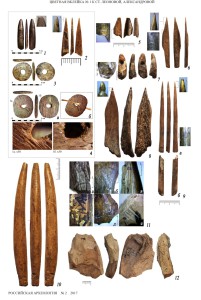 Elena V. Leonova*, Olesya I. Aleksandrova*, Natalya V. Serdyuk**
Elena V. Leonova*, Olesya I. Aleksandrova*, Natalya V. Serdyuk**
*Institute of Archaeology RAS, Moscow, Russia (lenischa@yandex.ru, adamena@mail.ru)
**Palaeontological Institute RAS, Moscow, Russia (nataly@paleo.ru)
Keywords: Upper Palaeolithic, Northwest Caucasus, bone artefacts, morphology, technology, use-wear studies.
This paper describes bone artefacts from the Upper Palaeolithic layer of the multilayer site of the Dvoynaya cave tentatively dated to 13,000 BP. A small collection including several awls, a needle fragment, a chisel-like tool and some non-utilitarian articles is examined in the light of the morphological, technological and use-wear analyses. The collection is characterized by a restricted functional set of tools to the total exclusion of hunting equipment, isolated cases of decoration by rows of parallel notches, and the lack of horn articles. Such a set is typical of other synchronous sites of the North Caucasus and shows analogies with the record of the Upper Palaeolothic layers of the Mezmay cave. The restricted both qualitatively and quantitatively set of bone tools can be accounted for by the fact that bone was used as a raw material only sporadically while mountings and handles were made of wood, which is implied by the presence of numerous planing, cutting and scraping implements in the collection of stone tools. The group of awls displays variations of shapes owing to both the nuances of their functional application and their individual and not serial manufacture. A specific device of cutting the tooth crown while fashioning pendants was discovered and the way of fastening small flat beads reconstructed. The use-wear analysis revealed a wide range of bone treatment techniques of the Upper Palaeolithic of the North Caucasus while functionally bone tools were only used to treat hides and skins.







